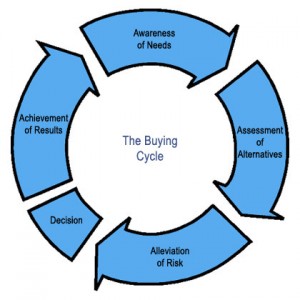Stages in the B2B Buying Process and B2B Buying Situations
This section outlines the stages of the B2B buying process, explains the scorecard process of evaluating proposals, and describes the different types of B2B buying situations and how they affect sellers. Some companies use a single supplier. This helps streamline the company's paperwork and other buying processes. Buying from one seller and in huge volumes may allow for deeper discounts, also. Buying from a single supplier, however, is risky. The supplier may not deliver on the product, may go out of business, or raise its prices. For these reasons, many firms prefer to do business with more than one supplier. Doing business with multiple suppliers also keeps suppliers on their toes; they know that if they don't perform well for a buyer, the buyer can easily get the product from someone else.
Stages of the B2B buying process:

- A need is recognized - someone recognizes that the organization has a need that can be solved by purchasing a good or service. Users often drive this stage.
- The need is described and quantified - a buying center or a group of people brought together to help make buying decisions, describe what they believe is needed, the features it should have, how much of it is needed, where and so on.
- Potential supplier are searched for - people involved in the buying process seek out information about the products they are looking for and the vendors that can supply them.
- Qualified suppliers are asked to complete responses to requests for proposals (RFP) - each vendor that makes the cut is sent a request for proposal, which is an invitation to submit a bid to supply the good or service. The RFP outlines what the vendor is able to offer in terms of its products.
- The proposals are evaluated and suppliers selected - organizations will rank parts of the proposal differently, based upon their goals and the products they purchase. Price might be more important to some sellers; for others it may be follow-up service. Some companies use a scorecard approach to evaluating suppliers. See Figure 4.7
- An order routine is established - This is the stage in which the actual order is put together. The order includes the agreed-upon price, quantities, expected time of delivery, return policies, warranties and any other terms of negotiation.
- A post-purchase evaluation is conducted and the feedback is provided to the vendor - B2B buyer evaluates the purchase experience and decides if the relationship with a particular supplier is worth continuing. Some buyers establish on-time performance, quality, customer satisfaction, and other measures for their vendors to meet and provide those vendors with the information regularly such as trend reports that show if their performance is improving, remaining the same or worsening.
Some companies use a single supplier. This helps streamline the company's paperwork and other buying processes. Buying from one seller and in huge volumes may allow for deeper discounts, also. Buying from a single supplier, however, is risky. The supplier may not deliver on the product, may go out of business, or raise its prices. For these reasons, many firms prefer to do business with more than one supplier. Doing business with multiple suppliers also keeps suppliers on their toes; they know that if they don't perform well for a buyer, the buyer can easily get the product from someone else.
